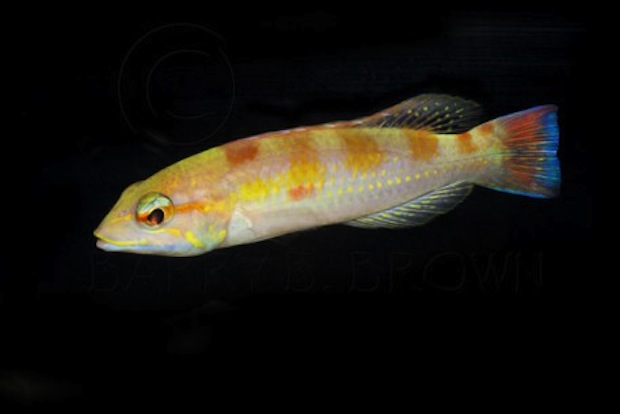Barry Brown is an avid underwater photographer that has spent the last decade or so documenting fish and other marvellous creatures in Curacao, and is working with the Smithsonian Institution in documenting new species from the deep waters of the Caribbean. In November last year, Barry released images of a two new Lipogramma sp, including a juvenile. Now he’s back with more Curacao goodies, including a gorgeous undescribed Decodon.
The only known Decodon from the Atlantic so far is D. puelleris, but there are possibly two other unknown Decodon wrasses that live in the deep waters of Curacao. The 4 inch specimen headlining this article was caught between 400-600 ft using the curasub. Like most of the deepwater basses and perchlets that live too far down for rebreathers, the curasub is employed to bring them up from where humans are unable to go. Decodon is a small genus, currently standing at four species, with one each being distributed in the Indian, Western and Eastern Pacific, and Western Atlantic Oceans respectively.
These Bodianus type wrasses prefer the protection of deeper waters, and with that comes the possibility of finding new species via deep sea exploration. The Decodon sp pictured above with a blue tail border is currently thought to be new.

The Smithsonian also managed to bring up a male Foetorepus agassizii dragonet from a bone crushing depth of 940ft. Yes you read that correctly. F. agassizii does not have a swim bladder, which makes it impervious to standard decompression maladies as it is being surfaced from 900 ft of water to sea level. At least two dragonets from Curacao have made it into the Japanese market in the past, and based on pictures and videos released, are likely to be F. agassizii as well. This means that Foetorepus has already made its aquarium debut in the past.
Like the Liopropoma aberrans, Lipogramma klayi and Liopropoma carmabi that were also caught in the same trip, this dragonet is already eating mysid shrimps.

Another deepwater beauty from Curacao that was also featured by Barry is no stranger to rare fish aficionados. The ever gorgeous Liopropoma carmabi (Candy Basslet) is a Curacao staple that never fails to impress. There’s something a little different about this specimen though. Barry reports in his blog that the local variation where these are caught sport a much “bluer” cast in its lavender stripes, and that other selected reefs harbour L. carmabi with different, albeit slight variations as well.
For more deepwater fish and undescribed Curacao netizens, make sure to check out Barry Brown’s amazing blog – Coral Reef Photos as he catalogues and feature some of the coolest fish from the Smithsonian and Curacao.



